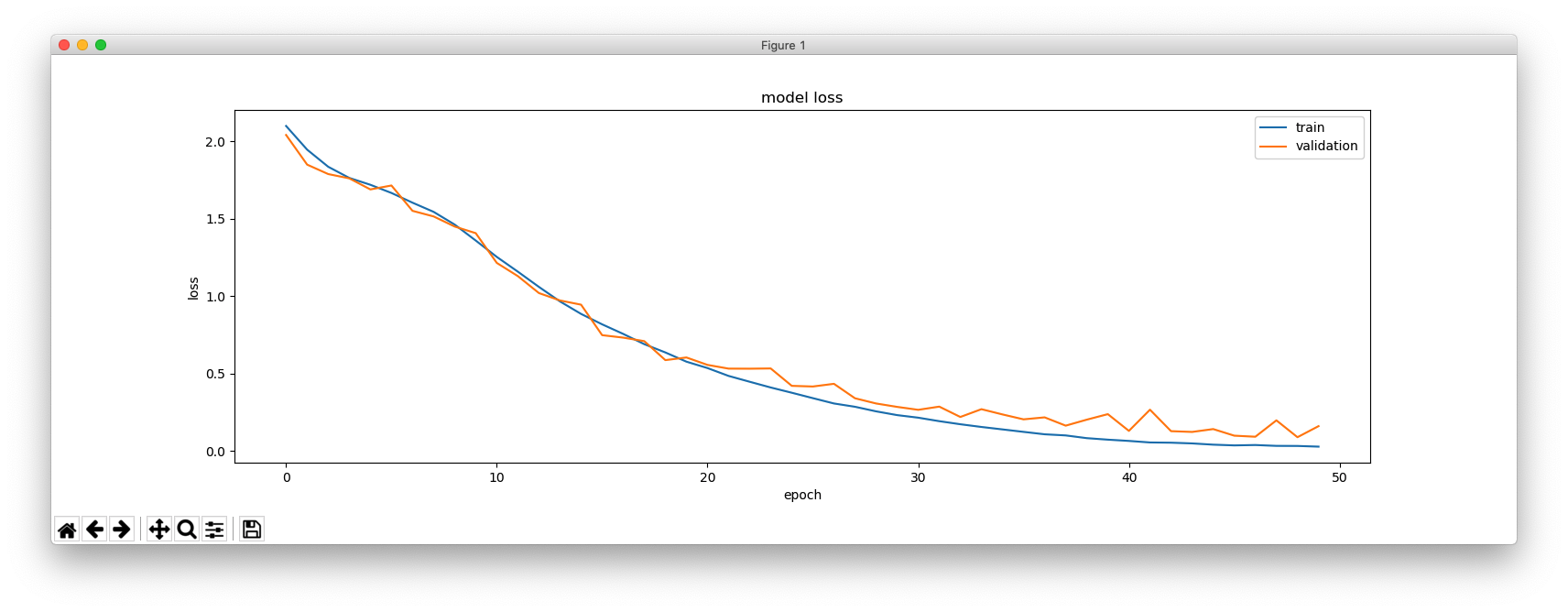a, .-
aa, .- .-
aal, .- .- .-..
aalii, .- .- .-.. .. ..
(many lines deleted)
zythia, --.. -.-- - .... .. .-
zythum, --.. -.-- - .... ..- --
zyzomys, --.. -.-- --.. --- -- -.-- ...
zyzzogeton, --.. -.-- --.. --.. --- --. . - --- -.
同じトレーニング系列を用いて、入力とターゲットとを逆にしてみます。
# input_text, target_text = line.split(', ')
target_text, input_text = line.split(', ')
トレーニングをしばらく行うと、さて、CWが読めるようになりました!
- Input sentence: .- -- . -. -.. . Decoded sentence: amende - Input sentence: ... - --- -.-. .- .... Decoded sentence: stocah - Input sentence: --. .-. --- .--. . Decoded sentence: grope - Input sentence: -... --- --. .- -. Decoded sentence: bogan - Input sentence: .. -- -... . .-. Decoded sentence: imber - Input sentence: -... .- -.-. -.-. .- Decoded sentence: bacca - Input sentence: .. -. -.. ..- -.-. . Decoded sentence: induce - Input sentence: ..-. .- -. Decoded sentence: fan - Input sentence: -.. .. .-. -.. Decoded sentence: dird - Input sentence: .- .-.. .-.. .. . Decoded sentence: allie
悪く無いでしょう?
max_word_lenght = 6
no. of available words = 33887
no. of words sampled = 10000
['amende, .- -- . -. -.. .\n', 'stocah, ... - --- -.-. .- ....\n', 'grope, --. .-. --- .--. .\n']
Number of samples: 10000
Number of unique input tokens: 4
Number of unique output tokens: 28
Max sequence length for inputs: 29
Max sequence length for outputs: 8
__________________________________________________________________________________________________
Layer (type) Output Shape Param # Connected to
==================================================================================================
input_1 (InputLayer) (None, None, 4) 0
__________________________________________________________________________________________________
input_2 (InputLayer) (None, None, 28) 0
__________________________________________________________________________________________________
lstm_1 (LSTM) [(None, 256), (None, 267264 input_1[0][0]
__________________________________________________________________________________________________
lstm_2 (LSTM) [(None, None, 256), 291840 input_2[0][0]
lstm_1[0][1]
lstm_1[0][2]
__________________________________________________________________________________________________
dense_1 (Dense) (None, None, 28) 7196 lstm_2[0][0]
==================================================================================================
Total params: 566,300
Trainable params: 566,300
Non-trainable params: 0
__________________________________________________________________________________________________
Train on 8000 samples, validate on 2000 samples
Epoch 1/50
from keras.models import Model
from keras.layers import Input, LSTM, Dense
import numpy as np
import random
import matplotlib.pyplot as plt
batch_size = 64 # Batch size for training.
epochs = 50 # Number of epochs to train for.
latent_dim = 256 # Latent dimensionality of the encoding space.
num_samples = 10000 # Number of samples to train on.
data_path = '../keras015/words_morse.txt'
max_word_length = 6
# Vectorize the data.
lines = []
input_texts = []
target_texts = []
input_characters = set()
target_characters = set()
with open(data_path, 'r', encoding='utf-8') as f:
for line in f:
english_text, morse_text = line.split(', ')
if len(english_text) <= max_word_length:
lines.append(line)
print("max_word_lenght = ", max_word_length)
print("no. of available words =", len(lines))
num_samples = min(num_samples, len(lines))
print("no. of words sampled = ", num_samples)
lines_sampled = random.sample(lines, k=num_samples)
print(lines_sampled[:3])
for line in lines_sampled:
# input_text, target_text = line.split(', ')
target_text, input_text = line.split(', ')
target_text = '\t' + target_text + '\n'
input_texts.append(input_text)
target_texts.append(target_text)
for char in input_text:
if char not in input_characters:
input_characters.add(char)
for char in target_text:
if char not in target_characters:
target_characters.add(char)
input_characters = sorted(list(input_characters))
target_characters = sorted(list(target_characters))
num_encoder_tokens = len(input_characters)
num_decoder_tokens = len(target_characters)
max_encoder_seq_length = max([len(txt) for txt in input_texts])
max_decoder_seq_length = max([len(txt) for txt in target_texts])
print('Number of samples:', len(input_texts))
print('Number of unique input tokens:', num_encoder_tokens)
print('Number of unique output tokens:', num_decoder_tokens)
print('Max sequence length for inputs:', max_encoder_seq_length)
print('Max sequence length for outputs:', max_decoder_seq_length)
input_token_index = dict(
[(char, i) for i, char in enumerate(input_characters)])
target_token_index = dict(
[(char, i) for i, char in enumerate(target_characters)])
encoder_input_data = np.zeros(
(len(input_texts), max_encoder_seq_length, num_encoder_tokens),
dtype='float32')
decoder_input_data = np.zeros(
(len(input_texts), max_decoder_seq_length, num_decoder_tokens),
dtype='float32')
decoder_target_data = np.zeros(
(len(input_texts), max_decoder_seq_length, num_decoder_tokens),
dtype='float32')
for i, (input_text, target_text) in enumerate(zip(input_texts, target_texts)):
for t, char in enumerate(input_text):
encoder_input_data[i, t, input_token_index[char]] = 1.
for t, char in enumerate(target_text):
# decoder_target_data is ahead of decoder_input_data by one timestep
decoder_input_data[i, t, target_token_index[char]] = 1.
if t > 0:
# decoder_target_data will be ahead by one timestep
# and will not include the start character.
decoder_target_data[i, t - 1, target_token_index[char]] = 1.
# Define an input sequence and process it.
encoder_inputs = Input(shape=(None, num_encoder_tokens))
encoder = LSTM(latent_dim, return_state=True)
encoder_outputs, state_h, state_c = encoder(encoder_inputs)
# We discard `encoder_outputs` and only keep the states.
encoder_states = [state_h, state_c]
# Set up the decoder, using `encoder_states` as initial state.
decoder_inputs = Input(shape=(None, num_decoder_tokens))
# We set up our decoder to return full output sequences,
# and to return internal states as well. We don't use the
# return states in the training model, but we will use them in inference.
decoder_lstm = LSTM(latent_dim, return_sequences=True, return_state=True)
decoder_outputs, _, _ = decoder_lstm(decoder_inputs,
initial_state=encoder_states)
decoder_dense = Dense(num_decoder_tokens, activation='softmax')
decoder_outputs = decoder_dense(decoder_outputs)
# Define the model that will turn
# `encoder_input_data` & `decoder_input_data` into `decoder_target_data`
model = Model([encoder_inputs, decoder_inputs], decoder_outputs)
# Run training
model.compile(optimizer='rmsprop', loss='categorical_crossentropy')
model.summary()
hist = model.fit([encoder_input_data, decoder_input_data], decoder_target_data,
batch_size=batch_size, epochs=epochs, validation_split=0.2)
# Save model
model.save('s2s.h5')
# Next: inference mode (sampling).
# Here's the drill:
# 1) encode input and retrieve initial decoder state
# 2) run one step of decoder with this initial state
# and a "start of sequence" token as target.
# Output will be the next target token
# 3) Repeat with the current target token and current states
# Define sampling models
encoder_model = Model(encoder_inputs, encoder_states)
decoder_state_input_h = Input(shape=(latent_dim,))
decoder_state_input_c = Input(shape=(latent_dim,))
decoder_states_inputs = [decoder_state_input_h, decoder_state_input_c]
decoder_outputs, state_h, state_c = decoder_lstm(
decoder_inputs, initial_state=decoder_states_inputs)
decoder_states = [state_h, state_c]
decoder_outputs = decoder_dense(decoder_outputs)
decoder_model = Model(
[decoder_inputs] + decoder_states_inputs,
[decoder_outputs] + decoder_states)
# Reverse-lookup token index to decode sequences back to
# something readable.
reverse_input_char_index = dict(
(i, char) for char, i in input_token_index.items())
reverse_target_char_index = dict(
(i, char) for char, i in target_token_index.items())
def decode_sequence(input_seq):
# Encode the input as state vectors.
states_value = encoder_model.predict(input_seq)
# Generate empty target sequence of length 1.
target_seq = np.zeros((1, 1, num_decoder_tokens))
# Populate the first character of target sequence with the start character.
target_seq[0, 0, target_token_index['\t']] = 1.
# Sampling loop for a batch of sequences
# (to simplify, here we assume a batch of size 1).
stop_condition = False
decoded_sentence = ''
while not stop_condition:
output_tokens, h, c = decoder_model.predict(
[target_seq] + states_value)
# Sample a token
sampled_token_index = np.argmax(output_tokens[0, -1, :])
sampled_char = reverse_target_char_index[sampled_token_index]
decoded_sentence += sampled_char
# Exit condition: either hit max length
# or find stop character.
if (sampled_char == '\n' or
len(decoded_sentence) > max_decoder_seq_length):
stop_condition = True
# Update the target sequence (of length 1).
target_seq = np.zeros((1, 1, num_decoder_tokens))
target_seq[0, 0, sampled_token_index] = 1.
# Update states
states_value = [h, c]
return decoded_sentence
def main():
for seq_index in range(10):
# Take one sequence (part of the training set)
# for trying out decoding.
input_seq = encoder_input_data[seq_index: seq_index + 1]
decoded_sentence = decode_sequence(input_seq)
print('-')
print('Input sentence:', input_texts[seq_index])
print('Decoded sentence:', decoded_sentence)
print(hist.history.keys())
plt.figure(figsize=(16, 5))
plt.plot(hist.history['loss'])
plt.plot(hist.history['val_loss'])
plt.title('model loss')
plt.ylabel('loss')
plt.xlabel('epoch')
plt.legend(['train', 'validation'], loc='upper right')
plt.show()
main()

